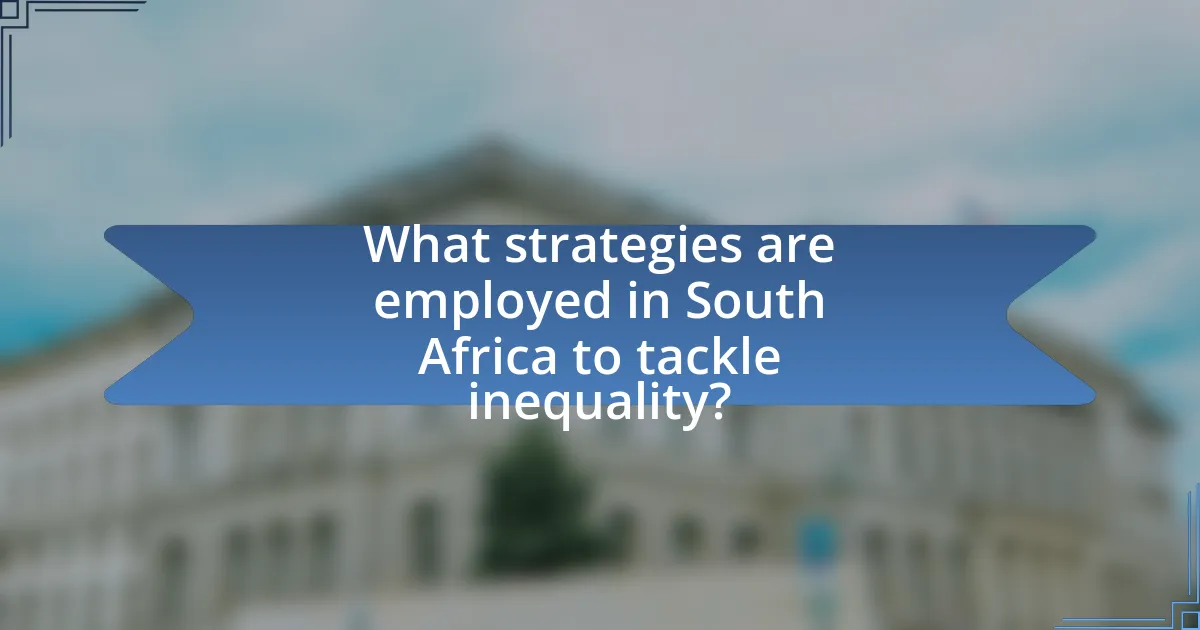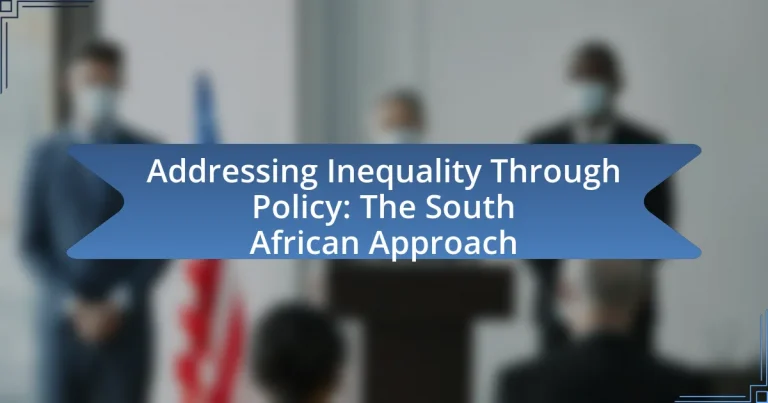The article examines the South African approach to addressing inequality through various policies, including redistributive measures, social welfare programs, and economic empowerment initiatives. Key policies such as the Broad-Based Black Economic Empowerment (B-BBEE) Act and social grants aim to promote economic participation and provide financial assistance to vulnerable populations. The historical context of apartheid significantly influences current policies, which seek to rectify past injustices and foster a more equitable society. The article also discusses the effectiveness of these policies, the challenges faced in implementation, and the importance of education and community engagement in reducing inequality.

What is the South African approach to addressing inequality through policy?
The South African approach to addressing inequality through policy focuses on redistributive measures, social welfare programs, and economic empowerment initiatives. The government implements policies such as the Broad-Based Black Economic Empowerment (B-BBEE) Act, which aims to promote economic participation among historically disadvantaged groups. Additionally, social grants, including the Child Support Grant and Old Age Pension, provide financial assistance to vulnerable populations, reducing poverty levels. According to the World Bank, these policies have contributed to a decrease in the Gini coefficient, indicating a reduction in income inequality over the past decade.
How has historical context shaped current policies on inequality in South Africa?
Historical context has significantly shaped current policies on inequality in South Africa by embedding the legacy of apartheid into the socio-economic framework. The apartheid regime, which lasted from 1948 to the early 1990s, institutionalized racial discrimination, leading to vast disparities in wealth, education, and access to resources among different racial groups. This historical injustice has necessitated the implementation of policies aimed at redressing these inequalities, such as the Broad-Based Black Economic Empowerment (B-BBEE) and land reform initiatives. For instance, the B-BBEE policy, introduced in 2003, aims to promote economic participation of black South Africans, directly addressing the economic imbalances created during apartheid. Additionally, the South African Constitution, adopted in 1996, enshrines the right to equality and has influenced various legislative measures aimed at promoting social justice and economic equity. These policies reflect an ongoing commitment to rectify historical injustices and foster a more equitable society.
What key events in South African history have influenced inequality?
Key events in South African history that have influenced inequality include the establishment of apartheid in 1948, the Land Act of 1913, and the end of apartheid in 1994. The apartheid system institutionalized racial segregation and discrimination, leading to significant economic disparities between racial groups. The Land Act restricted land ownership for black South Africans, resulting in loss of economic opportunities and resources. The transition to democracy in 1994 aimed to address these inequalities, but the legacy of apartheid continues to affect socio-economic conditions, as evidenced by persistent disparities in wealth and access to services.
How do past policies continue to affect present inequality levels?
Past policies in South Africa, particularly apartheid-era legislation, continue to perpetuate present inequality levels by entrenching socio-economic disparities. The legacy of these policies includes systemic barriers to education, employment, and land ownership for non-white populations, which have resulted in significant wealth gaps. For instance, the 2019 World Bank report highlighted that South Africa remains one of the most unequal societies globally, with a Gini coefficient of 0.63, largely due to historical injustices that limited access to resources for the majority. Additionally, the lack of equitable land redistribution has left many communities without the means to generate wealth, further exacerbating economic inequality.
What are the main objectives of South African policies aimed at reducing inequality?
The main objectives of South African policies aimed at reducing inequality include promoting economic growth, enhancing access to quality education, and improving social welfare. These policies are designed to address the historical injustices of apartheid, which left a legacy of economic disparity. For instance, the National Development Plan (NDP) aims to eliminate poverty and reduce inequality by fostering inclusive economic growth and creating jobs. Additionally, the government has implemented initiatives such as the Expanded Public Works Programme (EPWP) to provide temporary employment and skills development, thereby directly targeting unemployment and income inequality. Furthermore, policies like the Social Assistance Act provide financial support to vulnerable populations, reinforcing the commitment to social equity.
How do these objectives align with international standards on inequality?
The objectives of addressing inequality in South Africa align with international standards on inequality by promoting equitable access to resources and opportunities, as outlined in the United Nations Sustainable Development Goals (SDGs), particularly Goal 10, which aims to reduce inequality within and among countries. These objectives are supported by the South African Constitution, which emphasizes the right to equality and non-discrimination, reflecting international human rights frameworks. Furthermore, South Africa’s National Development Plan (NDP) aims to eliminate poverty and reduce inequality by 2030, aligning with global commitments to social justice and economic equity, as recognized in various international treaties and agreements.
What specific goals have been set by the South African government?
The South African government has set specific goals aimed at addressing inequality, including the reduction of poverty, the promotion of economic growth, and the enhancement of social cohesion. These goals are articulated in the National Development Plan (NDP), which targets the elimination of poverty and the reduction of inequality by 2030. The NDP outlines strategies such as improving education, increasing job opportunities, and ensuring access to basic services. Additionally, the government aims to achieve a more equitable distribution of resources through policies that support land reform and economic empowerment for historically disadvantaged communities.

What strategies are employed in South Africa to tackle inequality?
South Africa employs various strategies to tackle inequality, including social grants, land reform, and education initiatives. Social grants, such as the Child Support Grant, provide financial assistance to low-income families, helping to alleviate poverty and improve living standards. Land reform aims to redistribute land to historically disadvantaged communities, addressing the legacy of apartheid and promoting economic empowerment. Education initiatives focus on improving access to quality education for marginalized groups, which is essential for breaking the cycle of poverty. According to the World Bank, these strategies are crucial in reducing income inequality, as they target the most vulnerable populations and aim to create a more equitable society.
How does the South African government implement social welfare programs?
The South African government implements social welfare programs through a combination of cash transfers, social grants, and community-based initiatives aimed at reducing poverty and inequality. The government administers various social grants, including the Child Support Grant, Old Age Pension, and Disability Grant, which provide financial assistance to vulnerable populations. In 2021, approximately 18 million South Africans received social grants, highlighting the scale of these programs in addressing economic disparities. Additionally, the government collaborates with non-governmental organizations and community groups to enhance service delivery and outreach, ensuring that assistance reaches those in need effectively.
What types of social welfare programs are currently in place?
South Africa currently has several types of social welfare programs aimed at addressing inequality. These include the Child Support Grant, which provides financial assistance to low-income families with children; the Old Age Grant, which supports elderly citizens; and the Disability Grant, which offers aid to individuals with disabilities. Additionally, the Social Relief of Distress program provides temporary assistance to individuals facing extreme hardship. According to the South African Social Security Agency, these programs collectively aim to reduce poverty and improve the living conditions of vulnerable populations.
How effective are these programs in reducing inequality?
These programs are moderately effective in reducing inequality in South Africa. Evidence shows that initiatives such as the Expanded Public Works Programme (EPWP) and social grants have contributed to poverty alleviation and improved access to basic services. For instance, the EPWP has created over 1 million work opportunities since its inception, providing income to low-income households. Additionally, social grants have lifted approximately 3 million people above the poverty line, demonstrating a direct impact on income inequality. However, challenges remain, as the overall Gini coefficient, a measure of inequality, has only slightly improved, indicating that while these programs have made strides, systemic issues persist that require further policy intervention.
What role does education play in addressing inequality in South Africa?
Education plays a crucial role in addressing inequality in South Africa by providing individuals with the skills and knowledge necessary to improve their socio-economic status. Access to quality education can help bridge the gap between different socio-economic groups, as evidenced by the fact that individuals with higher educational attainment tend to have better employment opportunities and higher incomes. According to the World Bank, education is a key driver of economic growth and social mobility, which is particularly important in a country where historical injustices have led to significant disparities in wealth and opportunity. Furthermore, the South African government has implemented policies aimed at improving access to education, such as the National Development Plan, which emphasizes the importance of education in reducing inequality and fostering inclusive growth.
How has access to education changed over the years?
Access to education in South Africa has significantly improved over the years, particularly since the end of apartheid in 1994. The introduction of policies aimed at promoting equal access has led to increased enrollment rates, with primary school enrollment rising from 85% in 1994 to over 98% by 2020. Additionally, the government has implemented initiatives such as the National School Nutrition Programme, which supports disadvantaged students, and the provision of free education for the poorest households. These measures have contributed to a more inclusive education system, reducing historical disparities and promoting equity in educational opportunities.
What initiatives are in place to improve educational outcomes for disadvantaged groups?
The South African government has implemented several initiatives to improve educational outcomes for disadvantaged groups, including the National School Nutrition Programme (NSNP) and the no-fee schools policy. The NSNP provides meals to millions of learners, which enhances attendance and concentration in class, thereby improving academic performance. The no-fee schools policy ensures that children from low-income families can access education without financial barriers, contributing to increased enrollment rates. Additionally, targeted funding and resources are allocated to schools in underprivileged areas to enhance infrastructure and learning materials, further supporting educational equity. These initiatives are supported by data indicating that schools participating in the NSNP have seen improved attendance rates and academic results.

What challenges does South Africa face in its efforts to address inequality?
South Africa faces significant challenges in addressing inequality, primarily due to high levels of unemployment, systemic poverty, and historical socio-economic disparities. The unemployment rate in South Africa is approximately 34%, which exacerbates income inequality and limits access to resources for marginalized communities. Additionally, the legacy of apartheid has resulted in entrenched socio-economic divisions, with the Gini coefficient, a measure of income inequality, remaining one of the highest in the world at around 0.63. These factors create barriers to equitable access to education, healthcare, and economic opportunities, hindering the effectiveness of policies aimed at reducing inequality.
What are the main obstacles to effective policy implementation?
The main obstacles to effective policy implementation in South Africa include inadequate resources, lack of coordination among government agencies, and insufficient stakeholder engagement. Inadequate resources hinder the execution of policies due to budget constraints and limited human capital, which can lead to delays and suboptimal outcomes. Lack of coordination among various government departments results in fragmented efforts, where policies may not align or support one another, ultimately undermining their effectiveness. Insufficient stakeholder engagement, particularly with communities affected by the policies, can lead to resistance and a lack of trust, further complicating implementation efforts. These factors collectively impede the successful realization of policies aimed at addressing inequality in South Africa.
How do economic factors hinder progress in reducing inequality?
Economic factors hinder progress in reducing inequality primarily through systemic barriers such as unemployment, wage stagnation, and unequal access to education and resources. In South Africa, for instance, the unemployment rate was approximately 34% in 2023, significantly limiting economic mobility for disadvantaged groups. Additionally, wage disparities persist, with the top 10% earning more than 50% of total income, which exacerbates wealth inequality. Furthermore, access to quality education remains uneven, with poorer communities often lacking adequate schools and resources, perpetuating a cycle of poverty. These economic realities create a landscape where efforts to reduce inequality face substantial obstacles, as the foundational issues of job creation, fair wages, and equitable education must be addressed to foster meaningful progress.
What social barriers persist despite policy efforts?
Social barriers that persist despite policy efforts in South Africa include systemic inequality, racial discrimination, and economic disparities. Despite policies aimed at redressing historical injustices, such as affirmative action and land reform, the Gini coefficient remains high, indicating significant income inequality. Additionally, social issues like unemployment, particularly among youth, and limited access to quality education continue to hinder social mobility. Reports from the South African Human Sciences Research Council highlight that these barriers are deeply entrenched, often perpetuated by socio-economic conditions and cultural attitudes that resist change.
How does public perception influence policy effectiveness?
Public perception significantly influences policy effectiveness by shaping the political landscape and determining the level of public support for initiatives. When citizens perceive policies as beneficial or aligned with their values, they are more likely to support implementation and compliance, which enhances effectiveness. For instance, in South Africa, public opinion on land reform policies has been pivotal; positive perceptions can lead to greater community engagement and cooperation, while negative perceptions can result in resistance and protests, undermining policy goals. Research indicates that policies perceived as equitable and just are more likely to gain public backing, thereby increasing their success rates in addressing inequality.
What role does community engagement play in shaping policies?
Community engagement plays a crucial role in shaping policies by ensuring that the voices and needs of the community are reflected in decision-making processes. This involvement fosters transparency, accountability, and inclusivity, which are essential for effective governance. For instance, in South Africa, community engagement initiatives have led to the development of policies that address local issues, such as housing and education, directly informed by the experiences and insights of residents. Research by the Human Sciences Research Council indicates that policies co-created with community input are more likely to be accepted and successfully implemented, demonstrating the effectiveness of this approach in addressing inequality.
How can public awareness campaigns improve policy outcomes?
Public awareness campaigns can improve policy outcomes by increasing citizen engagement and informing the public about critical issues, which in turn pressures policymakers to act. For instance, campaigns that highlight social inequalities in South Africa have led to greater public discourse and advocacy for policies aimed at addressing these disparities. Research indicates that when citizens are informed and mobilized, they are more likely to participate in the political process, leading to more responsive governance. A notable example is the “Fees Must Fall” movement, which raised awareness about educational inequalities and resulted in significant policy changes regarding university fees.
What best practices can be adopted to enhance the South African approach to inequality?
To enhance the South African approach to inequality, implementing targeted social protection programs is essential. These programs should focus on providing financial assistance and access to essential services for the most vulnerable populations, such as low-income households and marginalized communities. For instance, the South African Social Security Agency reported that social grants have lifted millions out of poverty, demonstrating their effectiveness in reducing inequality. Additionally, investing in quality education and vocational training can equip individuals with skills necessary for better employment opportunities, thereby addressing the root causes of inequality. The World Bank has highlighted that improving educational outcomes can significantly contribute to economic growth and social equity in South Africa. Furthermore, promoting inclusive economic policies that support small and medium enterprises can create jobs and stimulate local economies, further mitigating inequality.
What lessons can be learned from other countries’ approaches to inequality?
Countries like Sweden and Denmark demonstrate that comprehensive welfare systems can effectively reduce inequality. These nations implement high taxation coupled with extensive social services, which provide universal healthcare, education, and social security, leading to lower income disparities. For instance, the Gini coefficient, a measure of income inequality, is significantly lower in these countries compared to South Africa, indicating more equitable income distribution. Additionally, Germany’s vocational training programs highlight the importance of education and skills development in addressing inequality, as they facilitate better job opportunities for lower-income individuals. These examples illustrate that targeted policies, such as robust social safety nets and accessible education, can mitigate inequality effectively.
How can collaboration between government and civil society improve policy effectiveness?
Collaboration between government and civil society can significantly improve policy effectiveness by enhancing accountability, increasing public participation, and leveraging local knowledge. When governments engage with civil society organizations, they can tap into grassroots insights that reflect the needs and priorities of communities, leading to more relevant and targeted policies. For instance, in South Africa, the partnership between the government and civil society in initiatives like the National Development Plan has facilitated the inclusion of diverse perspectives, resulting in policies that address inequality more effectively. This collaborative approach has been shown to foster trust and transparency, which are essential for successful implementation and monitoring of policies.


